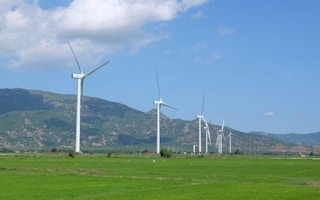Vietnam’s market for utility-scale renewables is on a roll.
To continue reading, subscribe to Eco‑Business.
There's something for everyone. We offer a range of subscription plans.
- Access our stories and receive our Insights Weekly newsletter with the free EB Member plan.
- Unlock unlimited access to our content and archive with EB Circle.
- Publish your content with EB Premium.
Less than a year after having no large-scale solar farms, Vietnam expects to have more than 4,200 megawatts (MW) of large-scale solar deployed and supplying power to the country’s grid by the end of June 2019 when the first feed-in-tariff (FIT) programme expires.
The onshore and offshore wind FIT incentive was recently increased, renewing investor interest and leading to estimates that more than 4,600 MW of wind projects could be completed by 2021.
By any measure, Vietnam adding more than 8,000 MW of new solar and wind to its energy mix within a few years is impressive, particularly as the country strives to reduce its emissions by up to 25 per cent while also meeting electricity demand that is expected to grow an average of 8 per cent annually through 2035.
But will commercial and industrial energy users - which account for 55-60 per cent of Vietnam’s electricity consumption and are increasingly demanding large supplies of clean energy - find a conducive market in Vietnam to fulfill their ambitious renewable energy goals?
Vietnam is already home to many multinational companies that are committed to “100 per cent renewables”, or have established science-based targets to reduce greenhouse gas emissions. For example, AEON, the Japanese shopping mall developer, and Anheuser-Busch InBev, the world’s largest brewery, have sizable presences in Vietnam and are both committed to “100 per cent renewables” through the RE100 programme. Samsung Electronics, which has more than $17 billion invested in Vietnam and accounted for nearly one-quarter of the country’s total exports in 2017, already has a 100 per cent renewable energy commitment for all of its facilities in the US, China and Europe by next year—and is actively seeking clean energy procurement options in its other manufacturing hubs like Vietnam.
It is important to note that these goals are not only for the Fortune 500 companies making commitments, but also apply to their supply chain partners. This means that a wide range of companies in Vietnam - large and small, domestic and foreign - are seeking increased and improved clean energy purchasing options.
Quite simply, for many of the world’s largest companies and their supply chains, shifting to clean energy is no longer an optional act of corporate social responsibility or goodwill. It’s an imperative that shareholders, customers, and the wider public are holding them accountable to.
Vietnam has signaled its desire to continue improving its attractiveness to world-class companies, particularly as the country positions itself for “Industry 4.0” and adapts toward a hi-tech focused foreign direct investment strategy.
For corporate energy users in Vietnam to have a realistic chance of meeting their clean energy goals, not only will gigawatt-hours upon gigawatt-hours of new renewables-based electricity need to be generated every year, but a robust toolkit of clean energy procurement choices will need to be made available.
Fortunately, Vietnam is making meaningful strides to develop into an attractive clean energy destination for large energy users. The country’s rooftop solar PV market has surged in recent months, growing from approximately 10 MW to 30 MW of total installed capacity, and industry stakeholders expect another 30-50 MW could go online before the current FIT program concludes on 30 June. This is just the beginning for rooftop solar: a draft regulation for the next wave of rooftop solar incentives and guidelines into 2021 is currently under review by the Ministry of Industry and Trade; the final version is expected to be announced in the next 1-2 months.
Additionally, Vietnam is nearing the final stages of approving and opening a pilot programme for direct power purchase agreements (DPPAs) to allow industrial energy users to purchase solar and wind power from private off-site solar and wind generators - a significant opportunity for companies needing as much clean energy as possible in their energy mix. The hope is that the pilot project will result in a long-term large-quota DPPA regulation to enable a wide variety of industrial energy users to procure renewables at their desired scale for years to come.
While a growing and improving rooftop solar PV market paired with an innovative DPPA pilot programme is a promising foundation for bolstering Vietnam’s attractiveness to corporate clean energy buyers, gaps and barriers still remain.
Next steps for corporate renewables
Recent retail electricity price increases in late-March may improve cost recovery for the utility, Electricity Vietnam (EVN), and make it easier for renewables to compete head to head with retail tariff rates. However, there remains little transparency about future electricity cost projections - diminishing an industrial energy user’s urgency to adopt energy efficiency and renewable energy solutions.
As is common with any new market for any new product, commercial lenders are not yet fully familiar and comfortable with new business models for corporate renewables, such as private rooftop solar leasing agreements. Thorough training and deeper experience sharing with domestic banks will be necessary to enable new types of project investments to reach scale.
Aside from addressing major market barriers like tariff cross subsidies and limited domestic lending options, Vietnam needs to see more mechanisms added to the menu of corporate renewable energy options that are not only cost-competitive but also trackable and additional.
For example, establishing a legal mechanism for accounting, tracking, and assigning ownership to renewable electricity generation and usage - such as renewable energy certificates - would enhance and deepen the portfolio of trackable, clean energy choices for businesses, while also providing new income streams for clean energy generators.
In addition, EVN and its subsidiaries - currently the sole buyers for all utility-scale solar and wind output - could offer utility green tariffs to large energy users, a product that would address the significant quantity of corporate clean energy demand that cannot be met through rooftop solar PV and direct power purchase agreement (DPPA) pilot contracts alone.
And in the coming years, as Vietnam transitions to a competitive, liberalised power market, the government could build on the work it has done to allow DPPA transactions between large energy users and renewable energy producers to consider additional programs that enable energy consumers more choice and negotiating power when securing a green energy supply from off-site generation sources. The Philippines’ Green Energy Option Program (GEOP), available to power consumers with a demand of 100 kilowatts (kW) or greater, is an example, regionally, of increased retail choice and flexibility for green power supply. Programmes like these spur demand for more clean energy investment while also expanding the clean energy purchasing menu for consumers.
Vietnam has many of the key ingredients already working in its favour to create a prosperous environment for corporate renewables. Solar and wind are reaching cost-competitiveness with commercial and industrial retail electricity prices, and domestic and international investors are lining up to build and operate new renewable energy projects.
Vietnam has made exciting progress shaping a market for utility-scale renewables, but much work remains in its transition to a clean economy. The corporate demand signal for clean energy options is clear and many of the building blocks are falling into place. Now Vietnam will need to take the next step by creating pathways that enable an electricity market with a wide variety of cost-effective, clean energy procurement choices for corporate energy users to decarbonise their businesses and supply chains, and in turn, the country’s energy mix.
Evan Scandling is a director for Allotrope Partners in Southeast Asia and acts as the Vietnam co-lead of the Clean Energy Investment Accelerator (CEIA), a multi-year, multi-country programme co-led by the U.S. National Renewable Energy Laboratory (NREL), the World Resources Institute (WRI) and Allotrope Partners.











